|
|
||||
|
|
|
|||
|
Tribal Baby Home Nappy Free Baby How to Start? How We Got Started Part Time DIAPER Free Part Time NAPPY Free Thrill of the First Catch Timing, Cues & Signs Prime Times for EC Baby's Point of View EC Clothing Directory My Grandma and EC Modern Cloth and EC Breastfeeding and EC Wearing Baby and EC EC in China Naked Bottom Time Practicing with Knickers Musing on Misses... Wee Miss Ponderings... EC at Night? Crawling and EC EC Changes - Adapt! New Signals to Spot Towards Independence Potty Practice Keeping Regular Dads Point of View Our Progress Links to Resources
Sleep Sharing |
"Golden Rules" for inviting baby to wee, or offering a potty stop...What are the Prime Times to offer a pee opportunity? It isn't too hard - when are you most likely to need to go? Babies are similar - though they go more frequently...The first list is the times we offered pee-breaks before we began to learn his signs, and actually still routinely do all of these pee breaks. They change, and after a while you get the awareness if all of them are needed or not, depending on baby's age and 'capacity'.
On Pure Timing:
(see "EC at Night" for a list of signs I respond to at night as they are quite different) As a Newborn and Young Baby:
As a grabbing and crawling baby:
Goodness - every five minutes? No! Sounds like pee-breaks every five minutes, but it isn't. They incorporate into your day, and not all these things happen in a day. Plus, you'll get it wrong and so will they - it doesn't matter at all - just keep practicing how to respond to what might be signs at those times you are able to tune into your EC senses, your 'baby radar'. Life will get in the way of course, at these times, well, we have a nappy or EC pants as backup, or use an EC mat for baby to sit or lay on, no worries. Keep it fun and an enjoyable way to connect. No need to try to catch everything, nor is that actually possible - you'd go nuts! As bubs gets older though, you'll naturally challenge yourself to keep them 'dry' for a few hours, or an afternoon, this is great fun to do. I kept him dry for a whole 24 hours at 4 months once - I was SOOO chuffed! It is helpful to be aware of possible signs to learn that might relate to your baby. I no longer give a pee-break before a shower, but I always took a second for a pee-opp before getting him into, and when taking him out of the car, until after 12 months, then I would do one or the other. It does take only a couple of seconds. Detective work: becoming aware of signs Spotting signs begins once you become aware of what the baby does before they pee. What I did was always offer for the timing pee-breaks, and then pick one or two of the others to watch for, to see if they 'applied' to us. If they do, they are then reinforced by responding to them. If not, we’d start looking for another sign. The signs are there, (or they later emerge with baby's growing muscle skills) - it is a slow process to start becoming aware of the first one your baby does, then it gets easier, then becomes fun. We are culturally conditioned to ignore many of them, for example when they pop on and off the boob people think the baby is not hungry or is being fussy, (or even worse - that there is a supply issue) when in fact the baby just needs to pee or poop and doesn’t want to do it on you! Learning to respond to them is very empowering and confidence building for a mum, absolutely awesome in fact! Locations
As a tiny baby we held him in arms over the laundry basin, the kitchen sink, the bathroom sink, outside, the toilet, the shower, the bath. A quick swish of water washes the sterile pee away. When out we use the toilet, the parent room tub, the grass, flowerbeds, even trees!!! No-one even noticed. The vast majority of the time we went to parent rooms, as they are quite numerous where we live. Now that he is older we use the bowl at night and the bathroom or laundry sink during the day. He is getting used to the toilet now as well, being held over it each day to wee. From 15-16 months he began climbing onto the potty himself, not yet using it independently, but as a signal for help. Number two
Here are some more tips on During a pee-opp
Declining pee-opps: "test runs" We still have plenty of what Chris named 'test runs' in a day. If he doesn't need to go he looks away or bored, then arches his whole body. If we know he definitely needs to go, we'll first turn on the tap, give him extra cuddles, possibly change locations and try again once he has relaxed, or a few minutes later. (see Adapting to changes for ideas and strategies for older babies who often go through a phase of this behaviour) About crying after a nap or during a pee... Sometimes when he was really little he would sometimes cry at a pee-opp, and then relax once he'd gone, and this was due to the pressure of a full bladder. It can be quite painful to him, so much so that he sometimes finds it hard to relax to pee it out! This still happens a lot after daytime naps. I just continue to hold him, whispering and cuddling him, turning on the tap, until he relaxes and tinkles. This never happens at night, though! As he has gotten older it has lessened, but still occurs now and then. When he started walking at 12 months, he could naturally wait longer after waking, and after naps by himself he would come out to have a pee; he never wet the bed.
In the shower from about 8-9 months, Maven would hit my leg, look up and call a whine or grizzle to alert me he needed to pee! It is odd to us (why not just pee?), but I have found it is a great place to daily respond to and reinforce his signs / signals/ calls. We are there anyway, less distractions for Mum! Each day I pick him up to give him a pee-break in the shower if he grabs his piggly-wiggly, calls out, or gets anxious. I wee him in patterns on the glass, that sort of thing, as he watches himself pee. If not in the shower, just after, or there may be a miss. Learn
Part Time Elimination Communication (EC) |
|||
|
|
|
|||
 Tribal Baby
Tribal Baby
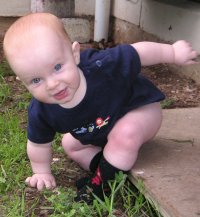 Below is a list of signs we responded to with Maven that
meant he needed to wee (or may have), roughly divided into age-ranges of
when we noticed and responded to them, and began encouraging them. Earlier signs
dropped away or changed into later signs, too. These are in the order of how we
‘discovered’ them as signs for us. The first is quite obvious once I was
aware to look for it, and second is a boon when learning about caring for a
baby, and the third became more obvious as his muscles developed and he
voluntarily held his pee longer to wait for a pee break (around one month of
age).
Below is a list of signs we responded to with Maven that
meant he needed to wee (or may have), roughly divided into age-ranges of
when we noticed and responded to them, and began encouraging them. Earlier signs
dropped away or changed into later signs, too. These are in the order of how we
‘discovered’ them as signs for us. The first is quite obvious once I was
aware to look for it, and second is a boon when learning about caring for a
baby, and the third became more obvious as his muscles developed and he
voluntarily held his pee longer to wait for a pee break (around one month of
age).
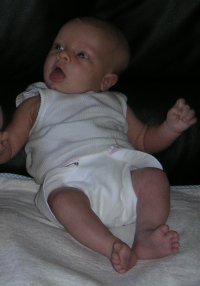 when babe pulls on-and-off the boob during a feed, 'plucking' is a good
description. This emerges over the first month.
when babe pulls on-and-off the boob during a feed, 'plucking' is a good
description. This emerges over the first month.
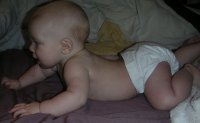 earlier signs +;
earlier signs +;
 Standing and walking baby:
Standing and walking baby: We
put a big mirror over our laundry tub (a lovely porcelain one actually). It is great – he enjoys watching
"Mirror Maven" and all the smiles and encouragement. We use a
wide bowl for peeing into in the main living area (moving it with us), or
whatever sink is around if moving at the time. It is always rinsed at the same
time, straight into the sewer system. In any case, baby wee is actually
sterile, so it is technically cleaner than after you brush your teeth and
spit! By the time they are bigger they can be supported over or sitting on a
baby potty. We used the Baby Bjorn Little Potty.
We
put a big mirror over our laundry tub (a lovely porcelain one actually). It is great – he enjoys watching
"Mirror Maven" and all the smiles and encouragement. We use a
wide bowl for peeing into in the main living area (moving it with us), or
whatever sink is around if moving at the time. It is always rinsed at the same
time, straight into the sewer system. In any case, baby wee is actually
sterile, so it is technically cleaner than after you brush your teeth and
spit! By the time they are bigger they can be supported over or sitting on a
baby potty. We used the Baby Bjorn Little Potty.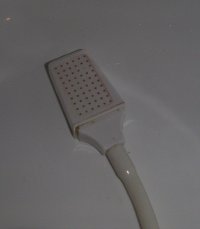 Maven liked to do his morning poops, his 'Bog runs' as Chris
named them, in the laundry basin over a flexible shower hose for the first 10
-11 months. It attaches to the tap and faces upwards, spraying warm water on his
bum like a bidet, and washing it as he goes. He loves it and seldom goes
elsewhere. It cost $2, was our best EC investment! Now that he is older he
generally goes each morning in his bowl after a long breastfeed. I keep a soft
cloth (t-shirt fabric or flannellette) under my pillow so there is always
something nearby in the early morning to wipe his bum bum. He'll be squirmy,
'pluck' a lot, grizzle uncomfortably before he needs to go. It is like a 'poop
radar' to me. We'll keep feeding until he goes, this helps him, then he's set
for the day and there aren't unexpected 'cluster pees' - whizzy winkles related
to an impending poopsie woopsie!
Maven liked to do his morning poops, his 'Bog runs' as Chris
named them, in the laundry basin over a flexible shower hose for the first 10
-11 months. It attaches to the tap and faces upwards, spraying warm water on his
bum like a bidet, and washing it as he goes. He loves it and seldom goes
elsewhere. It cost $2, was our best EC investment! Now that he is older he
generally goes each morning in his bowl after a long breastfeed. I keep a soft
cloth (t-shirt fabric or flannellette) under my pillow so there is always
something nearby in the early morning to wipe his bum bum. He'll be squirmy,
'pluck' a lot, grizzle uncomfortably before he needs to go. It is like a 'poop
radar' to me. We'll keep feeding until he goes, this helps him, then he's set
for the day and there aren't unexpected 'cluster pees' - whizzy winkles related
to an impending poopsie woopsie! If he is going to pee or poop he will become still, look down
and interested or focussed, do his business, then swing his legs, look away, and
then eventually arch to leave when he is done. We used to time a minute
when he was tiny - this is actually a long time standing there, but he often
needed it to get 'organised' enough to relax to pee back then. Now thirty seconds in
total is more than enough for pees.
If he is going to pee or poop he will become still, look down
and interested or focussed, do his business, then swing his legs, look away, and
then eventually arch to leave when he is done. We used to time a minute
when he was tiny - this is actually a long time standing there, but he often
needed it to get 'organised' enough to relax to pee back then. Now thirty seconds in
total is more than enough for pees.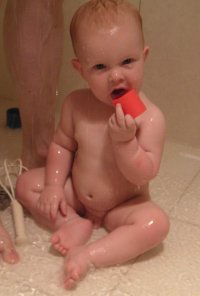 Showering as an EC tool!
Showering as an EC tool!

